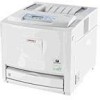Ricoh CL3500N Maintenance Manual - Page 12
Paper not supported by this printer - laser printer
 |
UPC - 026649024344
View all Ricoh CL3500N manuals
Add to My Manuals
Save this manual to your list of manuals |
Page 12 highlights
Paper and Other Media Additional cautions • Check the print side is facing down. • Check there is no air in the envelopes before loading. • For better print quality, we recommend the right, left, top, and bottom print margins to be at least 15 mm 0.6 inch. • Load only one size and type of envelope at a time. • Before loading envelopes, flatten their leading edges (the edge going into the printer) by running a pencil or ruler across them. • Some kinds of envelope might cause misfeeds, wrinkles or print poorly. • Print quality on envelopes may be uneven if parts of an enve- lope have differing thicknesses. Print one or two envelopes to check print quality. • Use flat envelopes with no curl. If they have a curl, flatten them. • Use completely flat envelopes that contain no air inside. • Do not print on both sides of envelopes. Paper not supported by this printer Avoid using the following paper as they are not supported by this printer. • Paper meant for an ink-jet printer • Bent, folded, or creased paper • Curled or twisted paper • Torn paper • Wrinkled paper • Damp paper • Paper that is dry enough to emit static electricity • Paper that has already been printed onto, except a preprinted letterhead. Malfunctions are especially likely when using paper printed on by other than a laser printer (e.g. monochrome and color copiers, ink-jet printers, etc.) • Special paper, such as thermal paper, aluminum foil, carbon paper and conductive paper • Paper whose weight is heavier or lighter than the limitation • Paper with windows, holes, perforations, cutouts, or embossing • Adhesive label paper on which glue or base paper is exposed • Paper with clips or staples • Do not use the following envelopes: • Envelopes with multiple flaps • Envelopes with a peel-off adhesive strip • Envelopes with windows or clasps 12















